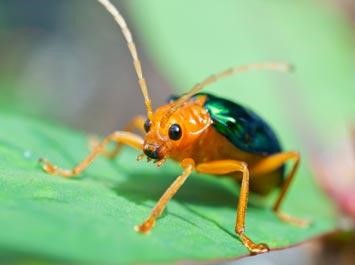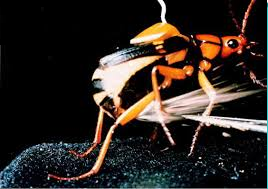
Don't Bug Me
Phil Kesten
Physics plays a role in the way many animals find food, find a mate, and find their way back home. (For example take a look, for example, at The Birds and the Bees Know Physics.) A thread of science winds its way through the lives of various insects in the way they defend themselves. Let’s wonder a bit about one way that physics and chemistry play a role in the world of insects.

There are hundreds of species of bombardier beetle found all over the world. With bits of orange or yellow on a black body, and under an inch long, the bombardier looks relatively gentle. For a beetle, anyway.
But if you’re a predator looking to enjoy a beetle snack—BEWARE! Many species of bombardier beetle produce a high-pressure, high-speed, scalding-hot spray of toxic chemicals to ward off attacks.
How does the bombardier beetle pull off this neat trick? The beetle’s hot, high pressure spray starts with a combination of two chemicals commonly produced by insects. Even when mixed, however, these chemicals aren’t particularly reactive or explosive. It takes something extra—another chemical, plus a bit of thermodynamics—to make the bombardier beetle exciting.
The two primary chemicals the bombardier beetle mixes are hydroquinone and hydrogen peroxide. Hydroquinone is related to a chemical that hardens the exoskeletons of beetles and other insects. It can also cause severe irritation on skin; many insects secrete it as a defense mechanism. Hydrogen peroxide, a water molecule with an extra oxygen atom attached, is also commonly found in insects (and also animals). Hydrogen peroxide is a common byproduct of the reactions by which cells convert fuel to energy. It also appears to play a role in keeping cells healthy.

But just combining hydroquinone and hydrogen peroxide doesn’t produce the exothermic—energy releasing—reaction for which the bombardier beetle is known. The beetle must also secrete an enzyme into the mixture to break hydrogen peroxide into water and oxygen. When oxygen combines with hydroquinone an enormous amount of heat is released. This sends the temperature of the mixture soaring, and bang!, a foul-smelling, boiling mixture of liquid and gas explodes from the reaction chamber in the beetle’s abdomen.
You might wonder how the bombardier beetle avoids burning up its insides when it fires off a volley of boiling hot, toxic spray. Careful study of these beetles reveals that the flow of hydroquinone and hydrogen peroxide into the reaction chamber, and the resulting (mini) explosions, come as a series of rapid pulses. The walls of the chamber can cool just a bit in between pulses, preventing their temperature from getting too high.
The bombardier beetle isn’t the only insect that employs chemistry and physics to great advantage, or the only one that shoots chemicals out of its hind quarters! One kind of rove beetle—the genus Stenus—normally paddles about gently on the surface of ponds and streams. But should danger present itself, the Stenus rove beetle secretes a bit of chemical called stenusin from its anal glands. Stenusin is extremely hydrophobic, that is, it is violently repelled by water. As a result the beetle is propelled away at speeds nearly 25 times its paddling rate. If you scaled up the The Stenus rove beetle to human-being size, that would be the equivalent of about 400 miles per hour.
Bombardier and rove beetles probably haven’t taken any chemistry or physics classes. But they sure know how to use science to their advantage.
----------------------------------------------------
Questions to ponder:
The speed of the bombardier beetle’s noxious spray can be 3 m/s or more. You reach to pick up one of these beetles – about how much time after you see the spray do you have to pull your hand away before you get burned?
The Latin name for many kinds of beetles is “Brachinus;”the bombardier beetle is “Brachinus crepitans.” Why “crepitans?” (The English word “decrepit” comes the same word.)

